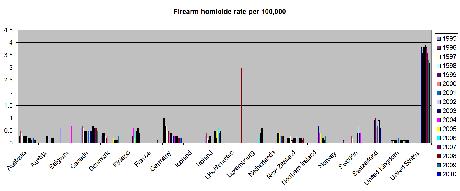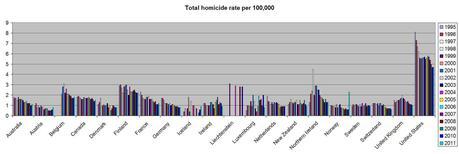By: danps Thursday September 5, 2013 1:46 pm
There is new interest in a 2007 study by Don B. Kates and Gary Mauser. “Would Banning Firearms Reduce Murder and Suicide?” was published in Harvard’s Journal of Public Law and Policy and has been cited recently on a number of political blogs, message boards, even on a popular right-leaning economics site. I encountered it at Writer Beat, one of the sites where I cross post. Announcing the publication by “Harvard, Obama’s Alma Mater” (apparently for the benefit of those who didn’t already know the place was a suspicious liberal bastion), the author summarizes its finding as “it’s not guns that kill people,” a commonly repeated phrase elsewhere.
Since I’m a good, open minded lefty, I decided to dig in to the paper and see if it challenged any of my beliefs. Before getting into the content I checked out a couple things, though. First, “Harvard study” conjures up images of nerdy, bespectacled professors with lab coats and slide rules indifferently inquiring as to the nature of the universe.(1) In this case, however, the authors’ backgrounds are decidedly partisan. Kates has written many books and articles in favor of gun proliferation, and Mauser is a lobbyist and enthusiast (via) on the issue. This doesn’t mean their opinions are invalid. Subject matter experts develop opinions, and as long as those opinions are at least arguably defensible there’s no problem. It’s good, though, for people to know up front what authors’ dispositions are. In this case it’s reasonable to expect a ringing endorsement of liberalized gun laws.
One other note: This does not appear to be a peer reviewed study. I didn’t see any indication of it, anyway. Again that doesn’t make it invalid, but it does mean the paper hasn’t been properly interrogated and should be considered less rigorous as a result.
That out of the way, I started reading – and couldn’t get past the first paragraph without having to stop for a reality check:
There is a compound assertion that (a) guns are uniquely available in the United States compared with other modern developed nations, which is why (b) the United States has by far the highest murder rate. Though these assertions have been endlessly repeated, statement (b) is, in fact, false and statement (a) is substantially so.The “other modern developed nations” are not specified, so I went with a list of those generally considered to be part of the West and that had a good amount of data available. That left a list of 20 nations. Kates and Mauser reference the Small Arms Survey; fortunately this Guardian article has the data linked in a spreadsheet. I’ve put a trimmed version of it in comma separated value (CSV) file on my site, so please feel free to look at the numbers yourself. Note any inaccuracies and I’ll correct them.
So is it, as the authors say, substantially false that guns are uniquely available in the United States compared with other modern developed nations? Here are the numbers (average firearms per 100 people) in descending order:
United States 89
Switzerland 46
Finland 45
Sweden 32
Canada 31
France 31
Norway 31
Austria 30
Germany 30
Iceland 30
New Zealand 23
Northern Ireland 22
Belgium 17
Luxembourg 15
Australia 15
Denmark 12
Ireland 09
UK (England and Wales) 06
Netherlands 04
Liechtenstein (N/A)
The US has nearly twice the gun ownership of the next closest country. It’s number one by a huge margin, no contest. The only substantially false thing is the very first factual assertion the authors make in their paper.
Next the authors claim as 100% false the notion that the US “has by far the highest murder rate.” They also spend a good deal of time on Soviet/Russian murder rates, as though that is one of the industrialized nations we should be comparing ourselves to and not, say, the UK. There’s also this bizarre statement that seems to have wandered in from a Red Scare pamphlet:
Since at least 1965, the false assertion that the United States has the industrialized world’s highest murder rate has been an artifact of politically motivated Soviet minimization designed to hide the true homicide rates.Right, so anyway on to homicide rates. Finding data for all the countries in question over a period of years was difficult (which may not be an accident), and I was not able to find complete data sets anywhere. The closest I found was the United Nations Office on Drugs and Crime (UNODC), which has spreadsheets for both overall homicide statistics and homicides by firearms. Combining those two with a great deal of tedious copying and pasting produced this (CSV) from which I created these graphs (click to enlarge):
Firearm homicide rate per 100,000
 (Mentally bookmark that big spike in 2008 for Liechtenstein.)
Overall homicide rate per 100,000
(Mentally bookmark that big spike in 2008 for Liechtenstein.)
Overall homicide rate per 100,000

So the paper begins with a pratfall. The problem is that establishing just how silly it is required a lot of work. I burned much more of my holiday weekend than I would have liked tracking down sources, assembling it into a usable format and looking at the results. Bad research takes time to correct, and examples like this show just how much play unreviewed results can get. (And it isn’t the first time even this year that a well publicized but unreviewed Harvard paper didn’t stand up to scrutiny.)
One more example of bad research. On the third page the authors produce a table with European gun ownership and murder rates. Since the US leads off the paper and plays such a central part in the debate it seems a bit curious to exclude it (by restricting the table to European rates). The inclusion of Russia is similarly weird if we are looking at a Western perspective on gun laws and murder rates. But the really unusual item in the table is Luxembourg. Look at that huge murder rate — with no guns to speak of! The authors make sure the reader’s attention is drawn to it as well: “For example, Luxembourg, where handguns are totally banned and ownership of any kind of gun is minimal, had a murder rate nine times higher than Germany in 2002.”
The numbers come from Statistics Canada, so I went there to gather some more data. I not only grabbed the 2002 data, but the data for two years on either side of it (2000, 2001, 2003, 2004) to see if Luxembourg really had the kind of murder rate the authors would have us believe. Also note that UNODC has Luxembourg’s murder rate for 2002 as 1.4, and its numbers for 1995-2011 all gather around that number. I’m not sure where the anomalous Statistics Canada number comes from; Luxembourg only shows up once in the Statistics Canada surveys I looked at:
Country 2000 2001 2002 2003 2004
Russia
19.68
21.13
20.54
19.82
United States 5.5 5.64 5.52 5.69 5.7
Finland
2.8
2.98
1.98
Hungary 2.14 2.48 1.99 2.22 2.22
Sweden
2
1.87
Australia
1.8
France 1.78 1.78 1.88 1.65 1.65
Canada 1.76 1.78 1.85 1.73 1.95
England and Wales 1.37 1.66 2.01 1.93 1.62
Italy
1.32
Switzerland
0.95
1.18
0.99
0.99
Japan
0.52
0.51
0.51
Austria
1.93
0.8
Ireland
1.6
Germany
1.05
1.11
0.99
0.99
Norway
0.81
Luxembourg
9.01
Portugal
2.57
Denmark
1.99
1.21
1.21
Australia
1.85
1.63
1.51
The one time it shows up is with a really out of whack number, unrepresentative of its history or its neighbors’ history, and in a way that happens to serve the authors’ purposes beautifully.
Here’s where to recall the 2008 firearm homicide rate for Liechtenstein. Most years the country has zero homicides, and in the years they have homicides it usually is not a firearm homicide. But one year — 2008 — there was a single homicide by firearm. That was enough to make the homicide by firearm rate 100% – and to cause a huge spike in the corresponding graph. The lesson: in smaller countries, single events can have a disproportionate effect on rates. Yet the authors did not let their readers in on that phenomenon, and in fact did just the opposite — they trumpeted the result.
At this point I hadn’t even gotten through three pages of the widely heralded paper and found a number of serious problems. And again, tracking each of them down was time consuming. Going through the whole thing would literally take me months if not years. After all, I can’t spend all day doing this. (Though once some of that sweet, sweet Soros cash starts gushing in I will!) But encountering the issues I did early on makes me skeptical of the rest. It’s already sufficiently debunked to my satisfaction. Unfortunately that’s not true at the other end of the spectrum. Conservatives’ willingness to immediately credit something like this instead of digging in to it — not to mention their ability to create whole alternate universes – makes it hard to know how engage them on a factual level.
NOTES
1. Apologies to Harvard types for any distance between that and reality.
